Resident Commissioner of the Philippines
The Resident Commissioner of the Philippines was a non-voting member of the United States House of Representatives sent by the Philippines from 1907 until its internationally recognized independence in 1946. It was similar to current non-voting members of Congress such as Resident Commissioner of Puerto Rico and delegates from Washington, D.C., Guam, the Northern Mariana Islands and other United States territories.
| Resident Commissioner of the Philippines | |
|---|---|
 | |
| Inaugural holder | Benito Legarda Pablo Ocampo |
| Formation | November 22, 1907 |
| Final holder | Carlos P. Romulo |
| Abolished | July 4, 1946 |
Like current non-voting members, Resident Commissioners could speak and otherwise participate in the business of the House, but did not have full voting rights. Two were sent until 1937 when after the establishment of the Commonwealth of the Philippines, the number was changed to one.[1]
History
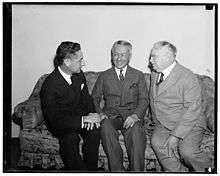
The Philippines was a United States territory from 13 August 1898 until Philippine independence was internationally recognized on 4 July 1946.
The office was first created by the Philippine Organic Act (1902) section 8 and re-authorized on its subsequent replacements—the Jones Law of 1916 (known as the Philippine Autonomy Act) section 20, and the Tydings–McDuffie Act of 1934 (known as the Philippine Independence Act) section 7(5).
The procedures for appointment of the Resident Commissioners were ambiguous and a source of friction.[2] Under the Insular Government, they were appointed by the American government-appointed Philippine Commission with agreement of the fully elected, fully Filipino Philippine Assembly. This conflict ended when the Tydings-McDuffle Act dissolved the Commission and replaced it with the Philippine Senate, the upper house of the new Philippine Commonwealth legislature.
Resident commissioners
| Territorial era | |||||
|---|---|---|---|---|---|
| Picture | Resident commissioner (lifespan) |
Party | Term start | Term end | Notes |
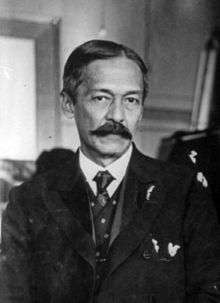 |
Benito Legarda (1853–1915) |
Federalist (Republican) |
November 22, 1907 60th Congress |
March 3, 1912 62nd Congress |
Retired |
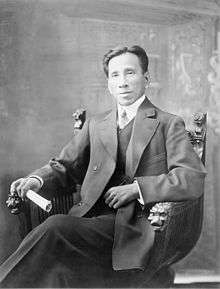 |
Pablo Ocampo (1853–1925) |
Democrat | November 22, 1907 60th Congress |
November 22, 1909 61st Congress |
Retired |
.jpg) |
Manuel L. Quezón (1878–1944) |
Nacionalista | November 23, 1909 61st Congress |
October 15, 1916 64th Congress |
Retired |
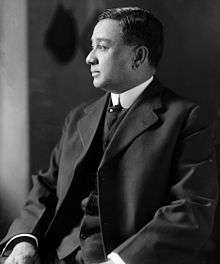 |
Manuel Earnshaw (1862–1936) |
Nonpartisan | March 4, 1913 63rd Congress |
March 3, 1917 64th Congress |
Retired |
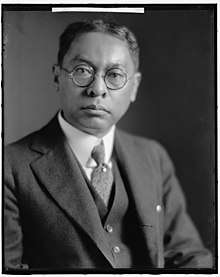 |
Jaime C. de Veyra (1873–1963) |
Nacionalista | March 4, 1917 65th Congress |
March 4, 1923 67th Congress |
Retired |
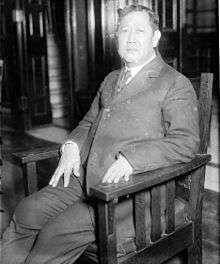 |
Teodoro R. Yangco (1861–1939) |
Nonpartisan | March 4, 1917 65th Congress |
March 3, 1920 66th Congress |
Retired |
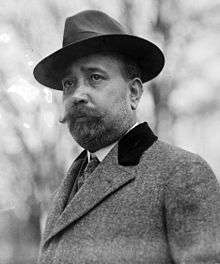 |
Isauro Gabaldón (1875–1942) |
Nacionalista | March 4, 1920 68th Congress |
July 16, 1928 70th Congress |
Resigned |
 |
Pedro Guevara (1879–1938) |
Nacionalista | March 4, 1923 67th Congress |
February 14, 1936 74th Congress |
Retired |
 |
Camilo Osías (1889–1976) |
Nacionalista | March 4, 1929 71st Congress |
January 3, 1935 73rd Congress |
Retired |
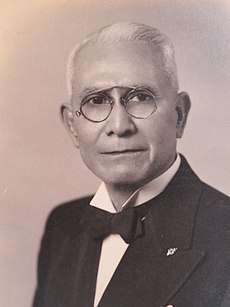 |
Francisco Afan Delgado (1886–1964) |
Nacionalista | January 3, 1935 67th Congress |
February 14, 1936 74th Congress |
Retired |
| Commonwealth era | |||||
 |
Quintín Paredes (1884–1973) |
Nacionalista | February 14, 1936 74th Congress |
September 29, 1938 75th Congress |
Resigned |
 |
Joaquín Miguel Elizalde (1896–1965) |
Nonpartisan | September 29, 1938 76th Congress |
August 9, 1944 78th Congress |
Resigned |
 |
Carlos P. Romulo (1899–1985) |
Liberal | August 10, 1944 78th Congress |
July 4, 1946 79th Congress |
Resigned; final Philippine representative |
See also
- List of Asian Americans in the United States Congress
- List of Hispanic and Latino Americans in the United States Congress
- Resident Commissioner
References
- Dorothy B. Fujita-Rony (2003). American Workers, Colonial Power. University of California Press. ISBN 0-520-23095-7.
- Kramer, Paul Alexander (2006). The Blood of Government: Race, Empire, the United States, & the Philippines. University of North Carolina Press. p. 325. ISBN 9780807856536.